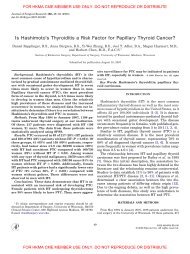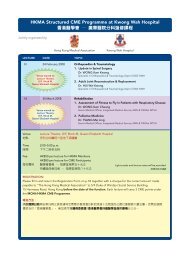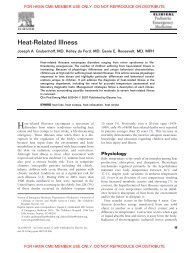Vaginitis & Management - Hkmacme.org
Vaginitis & Management - Hkmacme.org
Vaginitis & Management - Hkmacme.org
You also want an ePaper? Increase the reach of your titles
YUMPU automatically turns print PDFs into web optimized ePapers that Google loves.
<strong>Vaginitis</strong> & <strong>Management</strong><br />
Dr Mimi FUNG<br />
Associate Consultant<br />
O&G PMH
Physiological vaginal discharge<br />
Bacterial flora<br />
Lactobacillus acidophilus<br />
Diphtheroids<br />
Candida albicans<br />
Gardnerella vaginalis<br />
E. coli<br />
Group B streptcocci<br />
Genital mycoplasmatales
Physiological vaginal discharge<br />
Bacterial flora<br />
Water, electrolytes<br />
Cervical & vaginal epithelium<br />
pH 4.0<br />
White, flocculant, odorless<br />
Dependent areas of vagina
<strong>Vaginitis</strong><br />
Pruritis<br />
Discharge<br />
Odour<br />
Pain<br />
Dyspareunia<br />
Dysuria
Commonest Causes<br />
Bacterial vaginosis<br />
Candidiasis<br />
Trichomoniasis
Bacterial Vaginosis<br />
Commonest cause<br />
Not vaginitis. No single infectious agent<br />
A shift in composition of normal vaginal flora<br />
↑ anaerobes (10x)<br />
Gardnerella vaginalis, Mobiluncus, Mycoplasma,<br />
Ureaplasma, Gram negative rods / cocci,<br />
Steptococcus agalactiae (GBS)<br />
↓ Lactobacilli<br />
Not sexually transmitted
Bacterial Vaginosis<br />
Risk factors<br />
Foreign bodies (tampons, caps etc)<br />
Douching<br />
Sex toys, multiple partners<br />
Smoking<br />
OC Pills<br />
Antibiotics
Bacterial Vaginosis<br />
Signs & symptoms<br />
Vaginal wetness<br />
Discharge with odour<br />
Thin, homogenous, grey white<br />
Fishy odour<br />
Copious, adherent to vaginal walls<br />
Pruritis & vaginal erythema rare
Bacterial Vaginosis: Clinical diagnosis<br />
3 out of 4 Amsel’s criteria:<br />
1) Abnormal grey discharge<br />
2) Vaginal pH >4.5<br />
3) Positive “Whiff” test ( fishy odour on addition<br />
of 10% KOH)<br />
4) >20% vaginal epithelial cells being clue cells on<br />
Gram stain (borders obscured by adherent<br />
coccobacilli)<br />
Sensitivity 92% specificity 77%
Bacterial Vaginosis: Clinical diagnosis<br />
Nugent Gram stain scoring system<br />
<br />
Evaluates the no. of Lactobacilli,<br />
Gardnerella & Mobiluncus per oil<br />
immersion field<br />
0 – 3 Normal flora<br />
4 – 6 Intermediate flora<br />
7 – 10 BV flora
Bacterial Vaginosis: Association<br />
Non-pregnant women<br />
<br />
<br />
PID<br />
post-procedural gynaecologic infections<br />
(surgical abortions, hysterectomy)<br />
Pregnant women<br />
<br />
<br />
<br />
Preterm labour<br />
Low birth weight<br />
Premature rupture of membranes
Bacterial Vaginosis: Treatment<br />
<br />
<br />
Nitroimidazoles (Metronidazole)<br />
400mg tds po x 7 days<br />
500mg BD po x 7 days<br />
2g po as one dose<br />
not recommended in 1 st trimester of pregnancy<br />
Macrolides (Clindamycin)<br />
300mg BD x 7 days
Bacterial Vaginosis: Recurrence<br />
<br />
<br />
<br />
<br />
<br />
<br />
<br />
Up to 30% women recur within 3 months<br />
Persistence of pathogenic bacteria<br />
Reinfection from exogenous source<br />
Enquire into patient’s personal / sexual life<br />
Treatment of partner – no benefit<br />
Lactobacillus supplement – no benefit<br />
prolonged antibiotic therapy
Candidal vaginitis<br />
<br />
<br />
Normal vaginal habitant<br />
Estrogen dependent<br />
Candida albicans: 80-95%<br />
<br />
Candida glabrata<br />
Candida tropicalis<br />
Immunosuppression, hormonal changes,<br />
antibiotic therapy, obesity
Candidal vaginitis<br />
<br />
<br />
<br />
<br />
<br />
Pruritis<br />
Vaginal irritation<br />
Dysuria<br />
White, curd like, odourless<br />
Vaginal erythema with adherent plaques
Candidal vaginitis<br />
<br />
<br />
Wet smear with KOH: hyphae & buds<br />
Culture
Sobel (1998)<br />
Uncomplicated<br />
Sporadic<br />
Mild to moderate<br />
C. albicans<br />
Non immunocompromised<br />
women<br />
Complicated<br />
Recurrent<br />
Severe<br />
Non albicans<br />
candidiasis<br />
Uncontrolled DM<br />
Immunocompromised
Treatment<br />
Uncomplicated Candidiasis<br />
Local Azoles<br />
Miconazole<br />
Clotrimazole<br />
Fluconazole
Treatment<br />
Complicated / recurrent Candidiasis<br />
Fluconazole 150mg then a repeat dose 3 days<br />
apart<br />
+/- 150mg pulses weekly<br />
Ketoconazole 100mg QD x 6 months<br />
Itraconazole 50-100mg QD x 6 months<br />
Nystatin vaginal pessaries x 2 weeks<br />
Boric acid 600mg vaginally QD x 2 weeks
Trichomonasis<br />
Lower genital tract infection by Trichomonas<br />
vaginalis<br />
Asymptomatic to acute PID<br />
Vaginal discharge<br />
Malodorous<br />
Frothy<br />
Grey, or yellow green<br />
Vulvovaginitis, dysuria, dyspareunia, post coital<br />
bleeding
Trichomonasis<br />
Vaginal erythema ++<br />
“strawberry cervix”<br />
+ve amine test<br />
Wet mount: motile protozoans<br />
Pap smear<br />
Sensitivity 98% specificity 96%<br />
Diamond’s medium for culture
Trichomonasis<br />
Metronidazole<br />
2 grams po single dose<br />
500mg BD x 7 days<br />
400mg tds x 7 days<br />
Tinidazole<br />
2 grams singe dose<br />
∗Treat male partner
Cervicitis<br />
Mucopruluent cervicitis<br />
Chlamydia trachomatis<br />
Neisseria gonorrhoea
Chlamydia trachomatis<br />
Asymptomatic 30-50%<br />
Vaginal discharge / spotting<br />
Post coital bleeding<br />
Friable eroded cervix<br />
Yellow green pruluent discharge<br />
Endocervical swab for culture / antigen<br />
testing
Chlamydia trachomatis<br />
Treatment<br />
Azithromycin 1g PO x 1 dose<br />
Doxycycline 100mg BD PO x 7 days<br />
Erythromycin 500mg QID PO x 7 days<br />
Ofloxacin 300mg BD PO x 7 days<br />
Treat partner
Gonorrhoea<br />
<br />
<br />
<br />
<br />
<br />
<br />
<br />
Asymptomatic<br />
Vaginal discharge<br />
Dysuria<br />
Abnormal uterine bleeding<br />
Endocervical swab for culture<br />
Gram stain for diplococci<br />
Co-infection with Chlamydia
Gonorrhoea<br />
Treatment<br />
<br />
<br />
Ceftriaxone 250mg IM x 1 dose<br />
Ciprofloxacin 500mg PO x 1 dose<br />
Co-infection with Chlamydia<br />
<br />
Azithromycin 2g PO x 1 dose<br />
Treat partner
Other causes of vaginitis<br />
<br />
<br />
<br />
<br />
<br />
Local irritation<br />
Soaps, bubble baths, perfumed toilet papers,<br />
pads, powder, contraceptive agents, hygiene<br />
products, underwear<br />
Foreign bodies<br />
Tampons, condoms, tissue<br />
Sexual abuse
Other causes of vaginitis<br />
<br />
<br />
<br />
<br />
<br />
Atrophic vaginitis<br />
Inflammation of vagina secondary to lack of<br />
estrogen<br />
Localized burning, dryness, soreness,<br />
dyspareunia, spotting<br />
Dry and thin vaginal walls with little / no<br />
rugations<br />
Inflammation, petechiae, exudate
Treatment<br />
<br />
<br />
Local estrogen cream if no history of<br />
vaginal bleeding<br />
With history of vaginal bleeding,<br />
investigate before treatment
Diagnostic accuracy<br />
Useful History<br />
Discharge characteristics<br />
Itchiness<br />
Irritative symptoms<br />
Odour<br />
Less useful<br />
Dyspareunia, bleeding
Diagnostic accuracy<br />
Useful signs:<br />
Thick flocculent curdy discharge<br />
Moderate to profuse, malodorous, yellowish<br />
discharge<br />
Vaginal erythema
Diagnostic accuracy<br />
Office laboratory tests:<br />
Vaginal pH<br />
Microscopy<br />
Yeasts<br />
Bacilli with corkscrew motility<br />
Trichomonads<br />
Clue cells<br />
Whiff test
Empirical treatment<br />
Carr et al<br />
J Gen Intern Med 2005;20:793-799<br />
Vaginal pH < 4.9<br />
Fluconazole<br />
Vaginal pH > 4.9<br />
Metronidazole +/-<br />
Fluconazole
Problems<br />
Self treat<br />
Empirical treatment
Complementary / Alternative Rx<br />
Lactobacilli<br />
Yogurt<br />
Garlic<br />
Tea tree oil<br />
Douching<br />
Diet adjustment<br />
Hormonal manipulation
Vaginal discharge: Questions to ask<br />
Discharge<br />
Onset<br />
Duration<br />
Amount<br />
Colour<br />
Blood staining<br />
Consistency<br />
Odour<br />
Previous episodes<br />
Associated symptoms<br />
Itching<br />
Soreness<br />
Dysuria<br />
Intermenstrual /<br />
postcoital bleed<br />
Abdominal/ pelvic<br />
pain<br />
Dyspareunia
Thank you









